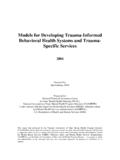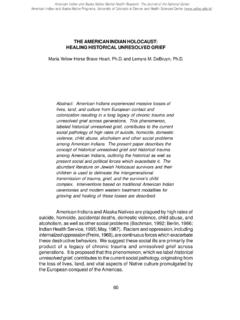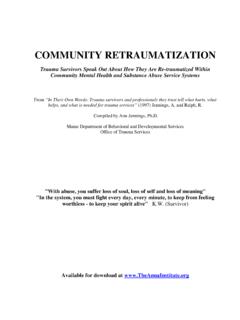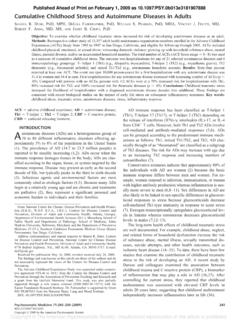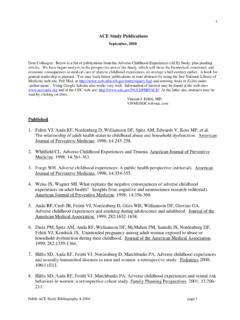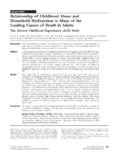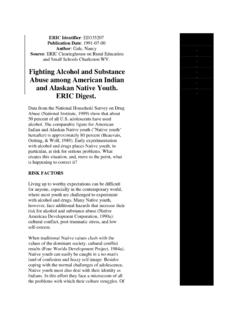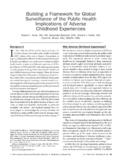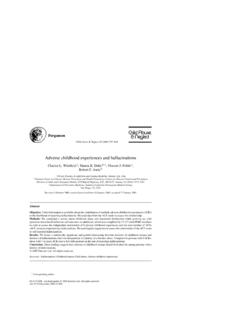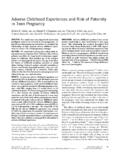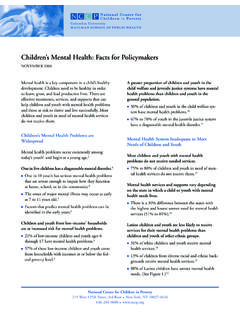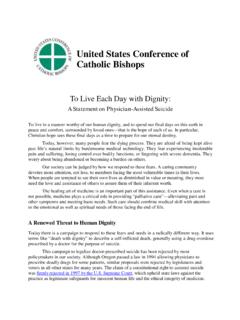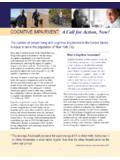Transcription of Trauma in Native Children - the anna institute
1 Trauma Exposure in American Indian/Alaska Native Children Dolores Subia BigFoot, PhD, Sadie Willmon-Haque, LCSW, and Janie Braden American Indian/Alaska Native Children million American Indian/Alaska Native1 (AI/AN) persons in ; of the population (1). 562 federally recognized tribes, 225 Alaska Native entities About million AI/AN Children under the age of 18 in the (2). What is Trauma in Indian Country2? A unique individual experience associated with a traumatic event or enduring conditions, which can involve an actual death or other loss, serious injury, or threat to a child s well-being (3), often related to the cultural Trauma , historical Trauma , and intergenerational Trauma that has accumulated in AI/AN communities through centuries of exposure to racism, warfare, violence, and catastrophic disease (4).
2 How Trauma is Experienced in Indian Country A single event (car accident, rape); Prolonged experience (historical events such as the removal from homelands, ongoing sexual abuse); Cumulative effects (high rates and exposure to violence, such as domestic violence and community violence); Personal events that impact several generations (boarding schools, massacres, forced relocation, early losses); Violent deaths (homicide; suicide; unintentional injuries); and Multiple victimization (two or more different types of victimizations). 1 American Indian and Alaska Native are terminology to designate the Indigenous People of the United States with the following terms used interchangeably with tribes, Native , Native people, and Indigenous people.
3 2 Indian Country is defined by Chapter 18, Section 1151 of the United States Code. In simple terms, Indian Country is any land granted by treaty or allotment to Native American nations, tribes, reservations, communities, colonies, or individuals and recognized by the federal government. There are about 285 federally recognized reservations, colonies, and communities in the United States. Reservations may consist of two or more traditional tribe s because of relocation dating from the 1800 s. 2008 BigFoot, Willmon-Haque & Braden 1 Oppression and Limited Infrastructure Increase Vulnerability of AI/AN Youth Lack of Mental health Services 100 AI/AN mental health professionals available per 100,000 AI/ANs, compared to 173 per 100,000 for Caucasians (5).
4 More than 55% of AI/ANs rely on Indian health Service (IHS) alone for their health care needs (6). Only 28% of AI/ANs have private health insurance (6). Most adolescents with substance use disorders are referred to one of 12 Indian health Service funded residential treatment facilities which are often geographically distant from their own communities (7). Cultural traditions are the preferred method of healing for mental health or substance abuse problems for many AI/ANs (8). Education AI/ANS are overrepresented in special education with significant variations among states; for example, 39% of AI/AN students in Florida have some type of disability where no AI/ANs in the District of Columbia were identified (9).
5 Poverty In 2006, 40% of AI/AN Children lived in poor families (10). AI/AN Children live in single parent families at the highest rates in the (2). The adolescent birth rate for AI/ANs (69/1000) is higher than the national rate (49/1000); births to AI/AN women younger than 20 years of age (1 in 5) is higher than the national rate (1 in 9) (11). While representing less than 2% of the population, it is estimated that AI/ANs constitute 8% of Americans who are homeless (12). High Death Rates In 2003, AI/ANs were times more likely to die from unintentional injuries ( per 100,000) compared to all races combined ( per 100,000) (13). AI/AN infant mortality rates were times higher than non-Hispanic Caucasian rates (13).
6 In 2001, AI/ANs had the highest rate of sudden infant death syndrome (SIDS) of all racial/ethnic groups ( per 1,000 live births), times higher than the rate for all populations ( per 1,000) (13). Victimization Victimization rate of AI/AN Children is 20/1000 compared to 10/1000 of non-Hispanic Caucasian Children (14). Compared to their peers, AI/AN Children are at times greater risk of experiencing Trauma (10). 2008 BigFoot, Willmon-Haque & Braden 2 Chronic health Problems AI/AN Children are times more likely to have diagnosed diabetes than Caucasian Children (15). AI/AN adolescents have two to four times the rate of sexually transmitted diseases (STDs) compared to Caucasians nationally and twice the proportion of AIDS compared to their national counterparts (16).
7 Major Mental health Problems and AI/AN Youth Depression AI/AN youth have higher rates of mental health and substance use problems than other ethnic groups (17). Psychiatric disorders may be common among AI/AN adolescent detainees at a juvenile detention center (18). Of 150 AI/AN youth, 49% had at least one alcohol, drug, or mental health disorder, has two disorders, and has three or more disorders (18). Depression among AI/AN Children ranges from 10-30% (5). Suicide In 2001, the suicide rates for AI/AN youth were three times greater than for Caucasians of similar age (19). In a survey of AI/AN adolescents (n=13,000), 22% of females and 12% of males reported having attempting suicide at some point (20).
8 AI/ANs age 15 to 24 have the highest rate of suicide, for AI/AN males and for AI/AN females (21, 22). PTSD In a sample of AI/AN youth, an average of lifetime traumas reported, with threat of injury and witnessing injury being the most common form of Trauma exposure (23). About 10% of AI/ANs youth in this study met the diagnostic criteria for posttraumatic stress disorder (PTSD) (23). Child Abuse and Neglect Alcohol abuse, related to child abuse and neglect, is more likely to be reported for AI/AN families (24). AI/AN Children appear to be more likely than Caucasian Children to be placed in foster care (24). Approximately 1 substantiated report of a child victim of abuse or neglect for every 30 AI/AN Children (25).
9 Among women who had Children placed in substitute care by child welfare, AI/AN families were the only group that seemed to have more negative child welfare outcomes ( , longer length of stay in substitute care and placement outcomes) (26). 2008 BigFoot, Willmon-Haque & Braden 3 Violence is more likely to be reported among AI/AN families, both as an element of abuse and/or neglect and in general (24). Domestic Violence AI/AN women are more than times more likely to be raped or sexually assaulted than women in the in general (27). In 2005, 39% of adult AI/AN women were victims of intimate partner violence (28). Substance Abuse Tobacco use is considerably higher among AI/AN than Caucasian youth (29).
10 Substance use and substance use disorders among AI/AN adolescents are significantly higher than non-AI/AN peers (30, 31). 50% of AI/AN youth in treatment for substance abuse have significant untreated psychiatric comorbidity (32). Parental histories of problematic substance use and childhood traumatic events are associated with substance use among AI/ANs (33). See References at Indian Country Child Trauma Center Center on Child Abuse and Neglect, University of Oklahoma health Sciences Center PO Box 26901 OUCP 3B3406 Oklahoma City, OK 73190 (405) 271-8858 (405) 271-2931 fax February 2008 2008 BigFoot, Willmon-Haque & Braden 4 References 1 Census Bureau (2006). Statistical Abstract of the United States: 2007 (126th Edition) Washington, DC.
